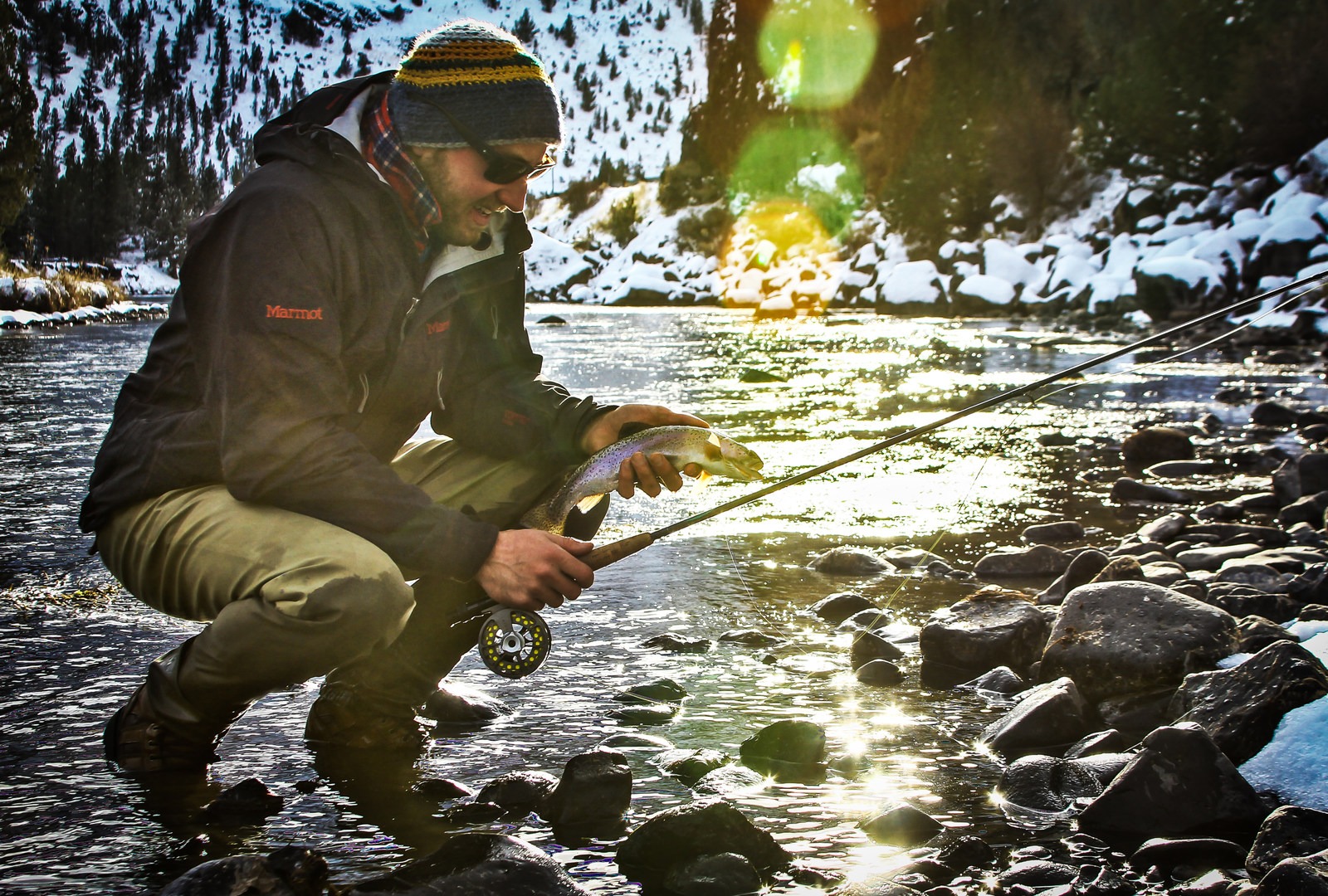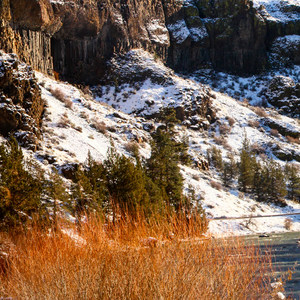You are here
My feet were cold before I even stepped into the river. A few resilient fall caddis adults fluttered above the water, but not enough to excite the shivering fish below. The low winter sun hovered behind me, casting my shadow up the stream bank as I scanned the tail end of a picturesque riffle for swirls and breaks in the current. After a few chilly minutes I saw a characteristically gentle dimple on the surface, the telltale sign of a rising fish that excites the winter angler more than Rush Limbaugh at an all-you-can-eat buffet. I watched her slurp flies from the surface for a few minutes in a seam 20 feet upstream. Most anglers would tie on a dry fly immediately but I knew she wouldn't be able to resist the tiny nymphs dangling from my tippet; I would just have to smack her in the face with them. I waded into the water, cast a few feet upstream, mended the line once and held my breath...
_________
An unusually intense cold snap made its way across the state yesterday, blanketing central Oregon with November's first snow. Call it a season's greeting from our neighbors to the north. Most folks in Oregon called it #snowpocalypse. Schools shut down across the state, roads and highways turned into a slushy ice rink, and the weather stations enjoyed the opportunity to broadcast endless hours of snow-related news. I enjoyed the opportunity to get the hell out of dodge and chase some early winter rainbows on the Crooked River.
Winter fly fishing is an experience characterized by short hatches of microscopic midges, bite-sized blue winged olives, frozen rod guides, and cold feet. The days are short, but the crowds are sparse and the fish are hungry. They spend most of their energy sipping practically invisible aquatic insets from behind boulders and avoiding being caught by slightly insane anglers like me.
I'd never fished the Crooked before, but I knew I needed to find a good tailwater section where the water flowing from the dam would be decently warm. I grew up casting to trout the size of some lap dogs on the North Platte River in central Wyoming, but for the last year I've been getting my bearings on the hundreds of rivers, streams, and lakes of Central and Southern Oregon. I stopped at Fly and Field Outfitters in Bend and Griff, the guide on duty, gave me a hand-drawn map with an "x" at a bend in the river. "If you fish this hole, you will catch fish," he told me. I bought a handful of midges and hit the road.
The snow stuck to the road like glitter glue and I passed a snow plow and probably a dozen skittish drivers on the frosty highway to Prineville Reservoir State Park, about 20 miles northeast of Bend. Something told me the other drivers were trying to get home and snuggle up next to the fire, not stand in a freezing cold river waving a stick, so I wasn't surprised when I soon found myself on top of the dam with an entire river valley to myself.
The pavement meanders along the riverbank for nearly 10 miles from the reservoir, which seemed like a blessing and a curse to me. I was raised on the theory that once you see even one other angler nearby it's time to go searching for a new fishing hole. The fish would still bite, I'm sure, but I drag myself to the river on days like these for more than just the chance to hook a few trout. Solitude is bliss.
I drove along the bank, watching the river twist and turn, wrapping itself around gentle sage-covered slopes. Paradise found. By the looks of it, that "x" could be on any one of these river bends and Griff's premonition would ring true. I found the riverside pull-off he marked on my map and slipped into my waders.
_________
It was so subtle I almost didn't notice when my indicator hesitated and dropped below the surface like a plastic submarine. I raised my rod and felt the delicate struggle of a hooked trout, a millimeters-thick wire hook and a single strand of fluorocarbon the only thing connecting me to the object of my desire. I quickly navigated her to the shore and into my net.
I had only been fishing for 15 minutes when I caught her, and in less time than that she was back in the water and my fly line was arcing above my shoulders, hurling and tumbling my flies to pockets I figured I would gravitate toward if I were a trout. After three more hookups and two more fish in net I found myself on the river bank sipping a thermos of dark coffee. The sun was dipping behind the gentle crest of the valley, flickering in a defiant golden hue before burning out. I thought about those folks and their fireplaces and I began to envy them.
It's a curious thing for a man to catch a fish simply for the sport, I thought, draining my coffee and ambling back to my car. It's as if he needs to prove to no one but himself his ability to beguile nature. Isn't it all pointless, really? Still, I can't deny the draw of the river. Wherever I go, I find myself scanning riffles and pools for hungry trout to stalk, catch, and then release like a lumbering giant through an innocent village.
A fish in hand, however is not a symbol of man's dominance but his wonderment. It is a sparkling ruby, the priceless bounty that is the life force of the river. To hold a fish in one's hand is to hold the secrets of the river, if only for a fleeting moment.
Being at the river always gives me a sense of place. Rivers shape our world in more ways than we imagine. We rely on them for providing drinking water, irrigating our food, cleansing our bodies, and keeping our ecosystems intact. But beyond that, the flow of the river is a soliloquy for the open ear. A parable on the passage of time. It is in all places at once and yet never moves. It is the thread that weaves the great tapestry of the natural world. The humble angler knows this and travels to its shores to pay homage like a dutiful pilgrim.
As I wound back to civilization the river faded into gray, and I thought about the stretches of water I would try on my next trip. The river, I reasoned, had caught and released me.






Comments
Sign In and share them.